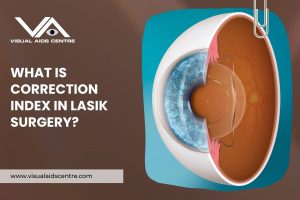Table of Contents
ToggleCorneal neuralgia is considered a rare but complex side effect of LASIK surgery, occurring in an estimated 1% to 2% of patients.
While LASIK has a success rate exceeding 95% and is considered a safe procedure, this condition highlights the importance of informed decision-making when considering corrective eye surgery.
What is Corneal Neuralgia?
Corneal neuralgia refers to chronic pain, hypersensitivity, or a burning sensation in the cornea—a critical part of the eye responsible for focusing light. It is typically linked to nerve damage or dysfunction in the cornea, which can occur during or after LASIK surgery. While most LASIK-related symptoms, such as dryness or mild discomfort, subside within a few weeks to months, corneal neuralgia presents as a prolonged and sometimes debilitating condition that can significantly impact the quality of life.
How Does LASIK Affect the Cornea?
The cornea contains a complex network of nerves known as the corneal nerve plexus, which controls sensations and ensures proper reflexes like blinking and tearing. During LASIK surgery, a corneal flap is created to reshape the underlying tissue and correct refractive errors. This process can disrupt or damage the cornea’s delicate nerve fibres, leading to a temporary or, in rare cases, persistent disruption in normal nerve functioning.
The Prevalence of Corneal Neuralgia After LASIK
Scientific research estimates that 1% to 2% of LASIK patients suffer from corneal neuralgia. However, the exact percentage may vary depending on the diagnostic criteria, surgical techniques used, and patient demographics evaluated in a study. Despite its relatively low prevalence, it’s a condition that eye care professionals take seriously due to its potential impact on patient well-being.
Symptoms of Corneal Neuralgia
Patients with corneal neuralgia often report a variety of symptoms, including but not limited to:
- Chronic Eye Pain: This may range from mild discomfort to severe burning or stabbing sensations.
- Light Sensitivity (Photophobia): Increased sensitivity to light, making it difficult to perform everyday tasks.
- Dry Eye Sensations (even if actual dryness isn’t present): Some patients describe feeling as if there is grit or sand in their eyes.
- Blurry Vision and difficulty focusing.
- Psychological Distress due to prolonged discomfort or pain interfering with daily activities, such as reading or working on a computer.
If you experience symptoms that persist or worsen after LASIK, it’s essential to consult your eye care provider promptly.
Causes of Corneal Neuralgia
1. Nerve Damage During Surgery
During LASIK, small incisions are made in the cornea to create a flap. While the cornea’s capacity for healing is impressive, in some cases, the regenerative process may not restore nerve function completely, leading to chronic neuralgia.
2. Underdiagnosed Pre-existing Conditions
Some patients may unknowingly have pre-existing nerve issues or dry eye syndrome, which can predispose them to more severe post-LASIK complications.
3. Excessive Eye Strain Post-Surgery
Demanding visual tasks without adequate recovery time post-surgery can exacerbate nerve irritation or symptoms of dry eye, potentially contributing to neuralgia.
4. Procedure Sensitivity
Even under optimal surgical conditions, some patients may have a heightened sensitivity to nerve disruption in the cornea.
5. Delayed Healing
While the majority of patients experience significant recovery within six months post-LASIK, others may face extended healing timelines that compound pain and discomfort.
Risk Factors for Developing Corneal Neuralgia
While any LASIK procedure carries a slight risk of neuralgia, certain factors may increase susceptibility, including:
- Severe Dry Eye Syndrome prior to surgery.
- Existing autoimmune conditions such as Sjögren’s syndrome or rheumatoid arthritis.
- Younger Age Groups (higher corneal nerve density).
- Thin Corneas (may require more intense surgical reshaping).
- Smoking or Poor Post-operative Compliance, which can hinder the healing process.
Diagnosing Corneal Neuralgia
Diagnosing corneal neuralgia is often challenging, as its symptoms can overlap with other LASIK-related complications like dry eye. A thorough diagnosis involves using specialised imaging tools, nerve sensitivity tests, and a detailed patient history. Advanced techniques such as confocal microscopy, a tool for examining corneal nerve structures, may also be used to identify nerve abnormalities.
Treatment for Corneal Neuralgia
While corneal neuralgia can be difficult to manage, several treatment options exist to help manage symptoms effectively. Treatment is often tailored to the severity of the condition and the patient’s specific needs.
1. Prescription Eye Drops
Anti-inflammatory or lubricating eye drops can improve corneal nerve function and relieve discomfort. Some eye drops specifically target neuropathic pain.
2. Neurostimulation Devices
Emerging technology like neuromodulators can help stimulate the regrowth of damaged corneal nerves and alleviate pain.
3. Medications
Oral medications, including nerve pain relievers like gabapentin or antidepressants, have been shown to reduce neuropathic symptoms.
4. Amniotic Membrane Therapy
Amniotic membrane grafts have been used as a regenerative treatment to promote healing and reduce inflammation in the cornea.
5. Scleral Lenses
Specialised contact lenses, known as scleral lenses, act as a protective barrier and provide relief from chronic irritation.
6. Lifestyle Adjustments
Reducing screen time, avoiding dry environments, and following a prescribed post-operative care regimen can help manage symptoms.
7. Surgical Interventions
While rare, in severe cases, surgical procedures like neurotisation (nerve grafts) are considered to address chronic neuralgia.
Preventing Corneal Neuralgia Post-LASIK
While it’s impossible to eliminate the risk entirely, several measures can minimise the likelihood of developing corneal neuralgia after LASIK surgery.
- Pre-surgical Evaluation
Ensure your surgeon performs a thorough assessment to identify any pre-existing conditions—like dry eye or autoimmune disorders—that could lead to complications.
- Choose an Experienced Surgeon
LASIK outcomes are closely tied to the skill and experience of the surgeon. Seek out a reputable and certified professional who has experience handling high-risk cases.
- Follow Post-operative Instructions
Strictly adhere to your doctor’s recovery protocols, including using prescribed eye drops and avoiding strenuous activities during the healing period.
To Sum Up
Corneal neuralgia after LASIK is a rare yet significant complication affecting approximately 1% to 2% of patients. While the vast majority of LASIK patients achieve life-changing vision correction with minimal issues, understanding potential risks like corneal neuralgia is crucial for making an informed decision.
By assessing your candidacy carefully, choosing an experienced surgeon, and following proper aftercare routines, you can significantly reduce the risk of complications. Consult with your ophthalmologist to weigh the benefits and risks of LASIK for your unique eye health profile.
If you’ve already undergone LASIK and experience prolonged discomfort or pain, don’t hesitate to seek specialised care. Prompt diagnosis and tailored treatments can alleviate symptoms and improve your quality of life.
Your eyes deserve personalised and expert care—because vision is invaluable.













